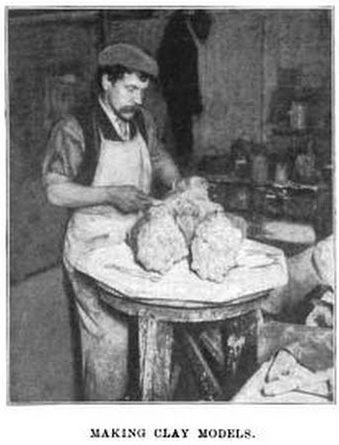The following comes from a 1901 magazine article:
Preparing the Drury Lane Pantomime
The property-master and his assistants are the “handy men” of the theatre. It is not generally known what a great deal depends upon the nimbleness of their fingers and the applicability of their minds. There is scarcely anything they cannot do in the way of constructive modelling. Almost everything that is required on the stage of a theatre is supplied by the property-man. If the real thing is not obtainable, or not desired, then a faithful imitation must be produced—an imitation, mark you, that, if it does not actually “take in” the beholder, must secure his admiration for its truthfulness. In short, the property-man is a kind of intellectual multum-in-parvo.

A great many theatrical properties are made of papier-mâché. It depends upon the nature of the article. At Drury Lane Theatre, where the accompanying photographs were taken, they have a well-equipped property-room and a large staff. Indeed, they are busy all the year round making something. The process of papier-mâché modelling is very interesting. The first stage is to form a model of the article required in clay, the latter being beaten into workable pliability with a wooden mallet. When the model is complete—and this first stage is not by any means the least skilful of the whole operation—it is treated to a coating of plaster-of-Paris, and a cast obtained. The latter, in its turn, is lined with papier-mâché, the process being a somewhat lengthy one, for the paper is carefully stuck on in thin layers until the required thickness is reached. Then it is removed from the plaster cast, and, being in sections, must be fitted together. This done, it is hung up to dry, and a very strange collection of objects are thus frequently seen in close propinquity—a rabbit ready for the cooking-pot, the head of a horse, a colossal egg, a bunch of grapes, a sea-serpent, a round of beef, a drinking-cup, a policeman’s pneumatic truncheon, a head of celery, cabbages, carrots, bloaters and kippers, all jumbled up in inextricable confusion.
After the drying come painting, gilding, and silvering. In the first-named the artist must apply many subtle touches of nature which make the whole akin to the real thing. And wonderfully like those models are made. It is quite appetising to gaze upon the representations of a succulent round of beef, a tender and plump-looking chicken, a bunch of juicy grapes, with the very bloom so skilfully introduced, and many other toothsome commodities to memory dear.
“Preparing the Drury Lane Pantomime.” Illustrated London News and Sketch 25 Dec. 1901: 372. Google Books. Web. 11 Apr. 2017. <https://books.google.com/books?id=I5hRAAAAYAAJ>.




